It’s interesting how much your body position affects how you can control your pistol. It’s not too much of a surprise, as it’s the same as martial arts and other combat sports. A good stance can make a world of difference in your shooting.
There are a variety of stances in the shooting world for each platform with three main stances in the handgun shooting realm. Naturally, each has its pros and cons.
Is there a best handgun stance for beginners?
As a humble student of the gun, I’m not arrogant enough to say that one is better than the other, but I do recognize the strengths of each. Each one has its applications and drawback, but it’s good to know them all and keep them in your arsenal.
The Weaver Stance
The Weaver was created by police officer Jack Weaver and was the first mainstream two-handed handgun shooting stance. As far as shooting stances go many find this one to be outdated. However, some reputable schools still teach it.
The Weaver Stance is very comfortable and relaxed in a lot of ways. The handgun is held somewhat close to the face which helps the user keep the gun away from potential opponents. It also makes it easier to find the front sight.
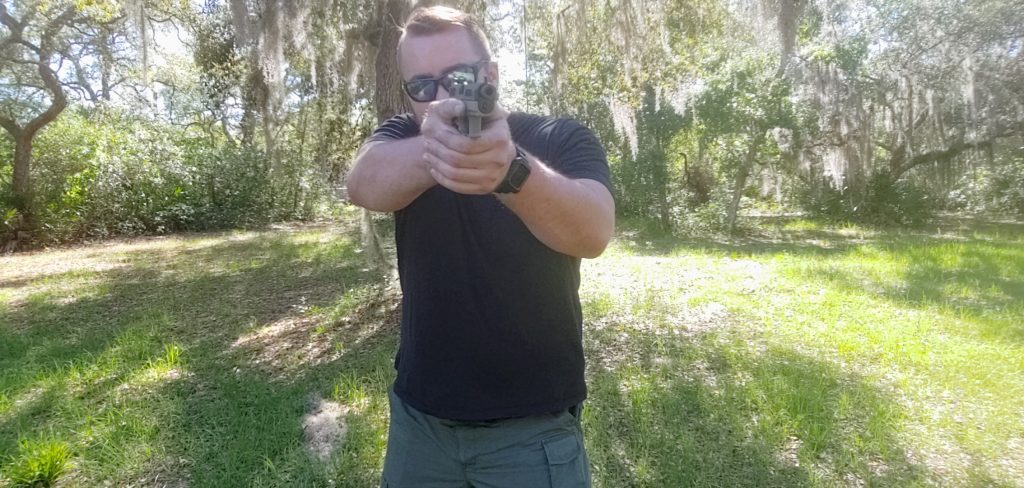
The Weaver Stance has your non-dominant leg forward, like a boxing stance, with the rear leg being used for support. There is a slight lean at the waist. The arms are extended, but not locked fully out. The dominant hand is pushing forward while the support hand is pulling rearwards.
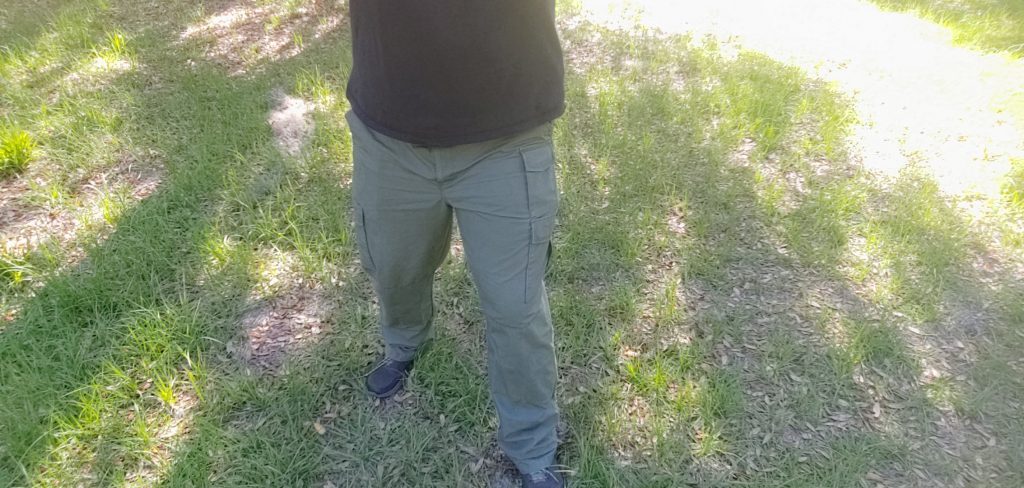
Pros
- Very comfortable and easy to maintain for extended periods of time
- By “blading” your body you are producing less of a target
- Very stable with staggered feet
- Quick and easy to learn
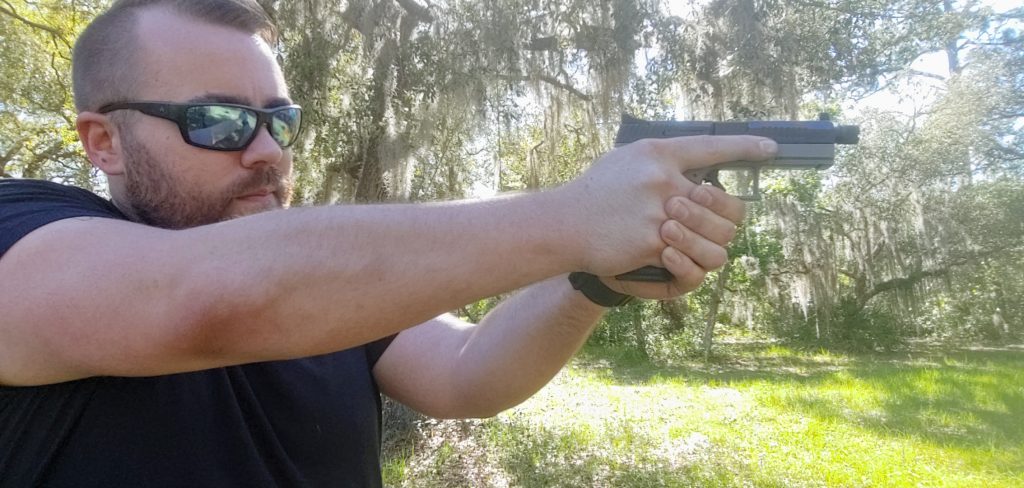
Cons
- Recoil mitigation isn’t as good as other methods
- Spinning to the non-dominant side is more difficult due to foot placement
- Largely out of style with pros because you present an un-armored portion of the body
Chapman stance
The Chapman stance is a modified Weaver stance designed by competitive shooter Ray Chapman. The differences here are slight, but important. The firing arm is fully extended and locked out, and the support hand is bent slightly less and facing downwards.
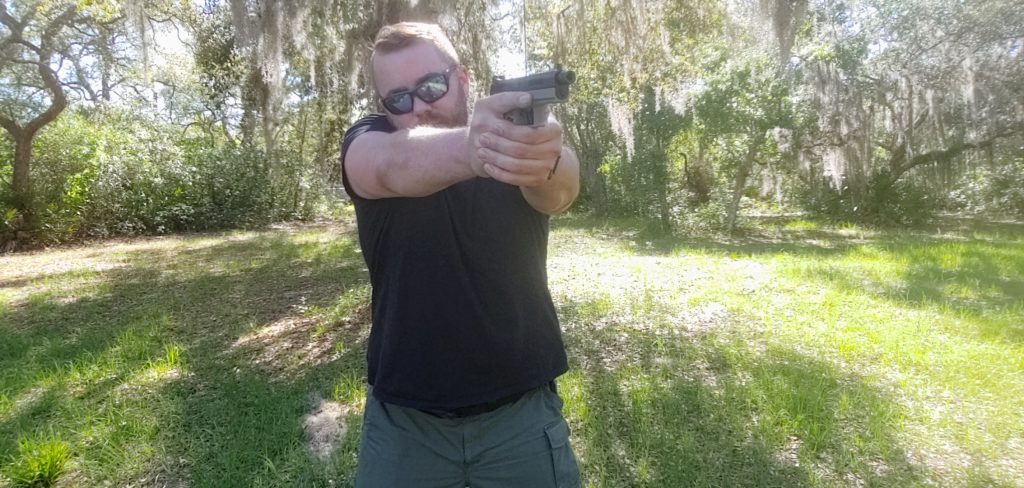
With the shooting arm fully extended you can rest your cheek on your biceps to acquire a steady sight picture. Your legs are slightly different from the Weaver. The front leg is pulled slightly closer in toward the other foot. This keeps things stable and keeps the shooter tight and ready to move quickly.
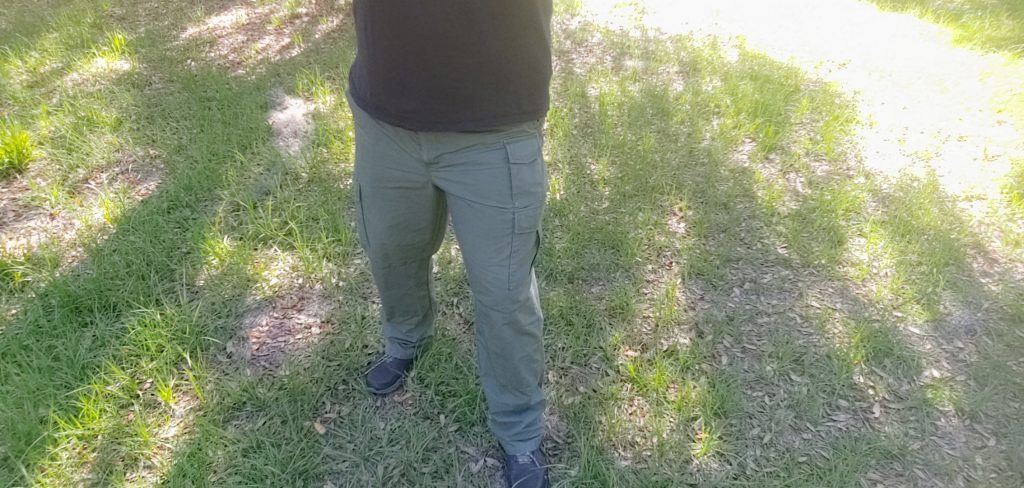
Pros
- Easier to control recoil with the locked out arm
- Comfortable and easy to learn
- Bladed body is a smaller target
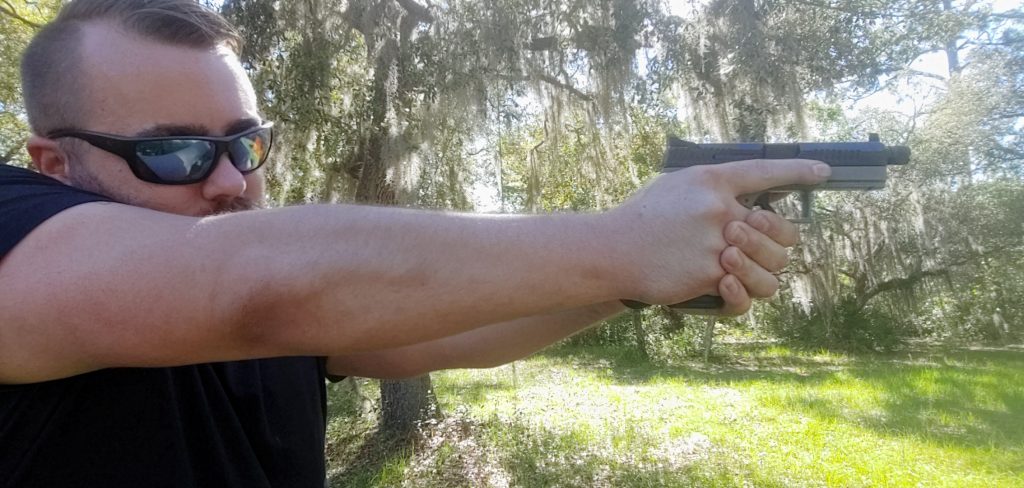
Cons
- Harder to hold than the Weaver for extended periods
- Can be straining
- Still difficult to move quickly to the non-dominant side.
Isosceles stance
Isosceles is the most stable position out there and lends itself well to modern tactical shooting. It’s simple and easy to learn, but can feel awkward at first.
For an isosceles stance you square up to the target. Position your legs shoulder width apart with both arms forward and locked out.
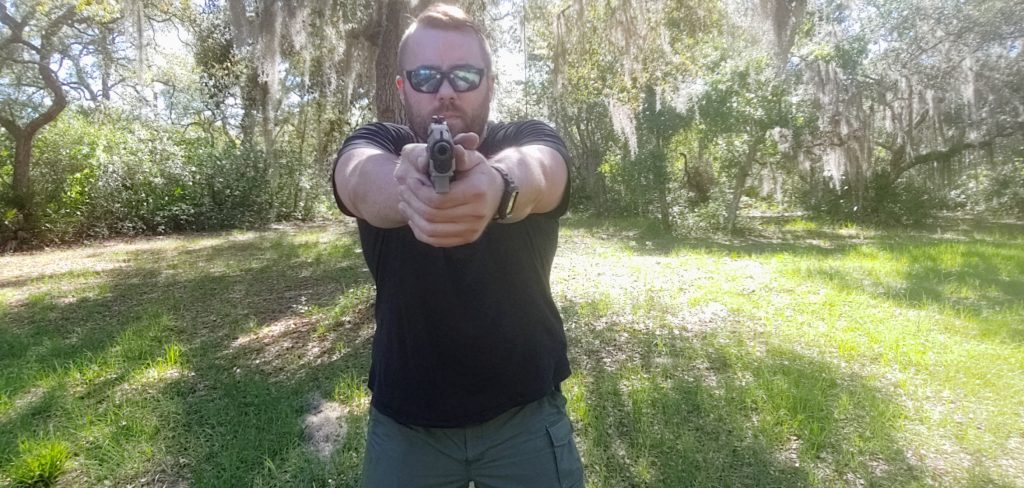
You are forming a triangle with your upper body. The bend slightly at the waist and bend the knees slightly. The isosceles offers a lot, but most of all it offers shooters who wear body armor the most coverage possible.
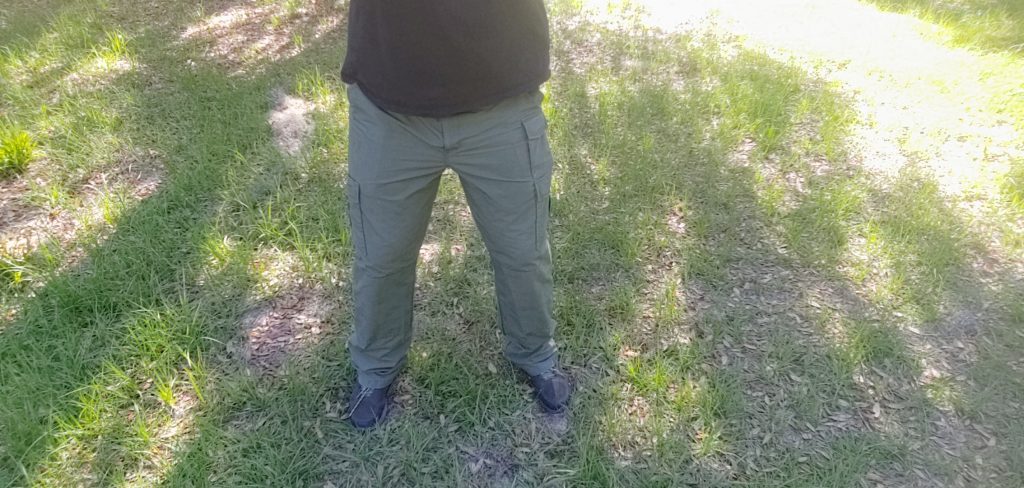
Pros
- Easy to learn
- Offers the best recoil control
- Quick and easy to transition left and right
- Easy to explode off the X in any direction
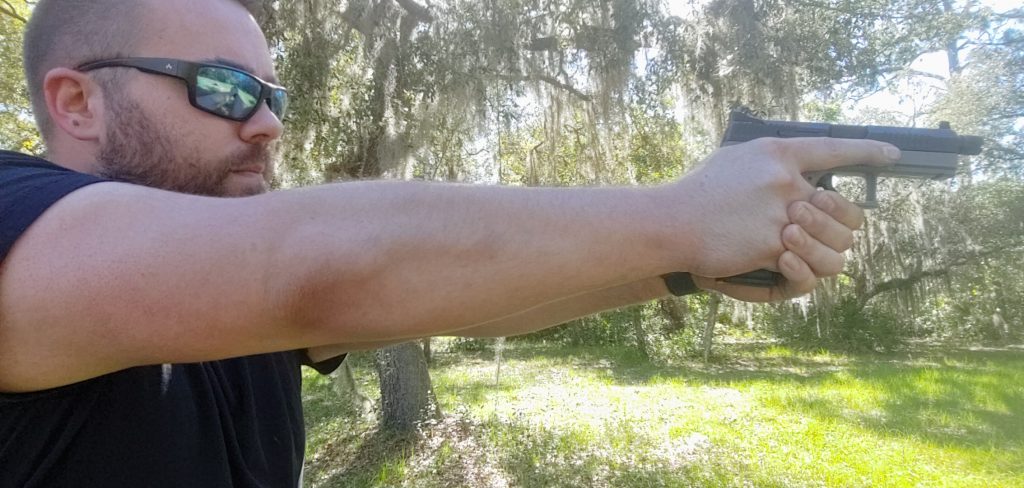
Cons
- Uncomfortable at first, feels awkward
- Arms tire after a day of shooting in this position, difficult to hold someone at gunpoint for an extended period.
- Non bladed stance gives your opponent a bigger target.
The right shooting stance
Choosing the right shooting stance for you is a matter of getting out there and shooting and — most importantly — training. I use the Chapman quite a bit due to a shoulder injury in my left arm, even though I’m trained in the isosceles. Find what works best for you.
The current pros mostly use the isosceles, but as anyone worth their spit would tell you, there is no right answer for everyone. I change my stance a bit between guns. For heavy duty revolvers, I use the Weaver because it helps balance the weight. For my Polymer 80 lower receiver GLOCK, I use isosceles.
Get out there, shoot in a variety of shooting stances and figure out which one allows you to shoot quickly, accurately, and do it repeatedly.
Travis Pike is a former Marine machine gunner who served with 2nd Bn 2nd Marines for 5 years. He deployed in 2009 to Afghanistan and again in 2011 with the 22nd MEU(SOC) during a record-setting 11 months at sea. Travis has trained with the Romanian Army, the Spanish Marines, the Emirate Marines, and the Afghan National Army.
He’s as an NRA certified pistol instructor and pursues a variety of firearms-based hobbies.





Good article. It’s basic and the basics need to be said once in a while. Life ain’t always high speed, low drag, ninja shit. I always thought of my shooting position, regardless of weapon, as a foundation. Same as for a building. A weak foundation is never a good thing.
Stances are great for learning to shoot and target shoot but stances are not relevant to gun fighting
D is absolutely correct. Watch any of the hundreds of LEO body-cam/dash-cam/surveillance-cam videos. I can’t think of a single one in which the good guy shooter executed ANY formal shooting stance. I say this as an academy FA instructor of nearly 30 years and tried to keep up with all the latest “modern” techniques, effective or not.
This is why people should learn to shoot from the isosceles, as a default training stance, if they can.
The reality is, when people are scared, they tend to default to something similar to the isosceles stance anyway. We are bipedal human beings with our eyes in the front. When frightened, we tend to square off at our threat and look at it head on, at least right in that first moment. That’s why it’s important to learn to draw from, and present your firearm from, this general stance.
No, it is not a good article. Any stance is strictly dependent on what you need it for. Numerous references to “The current pros mostly use …” is garbage unless you ARE a pro. If you are a competitive shooter, iso may be best for you. If you are personal defense, weaver may be best for you. If you are a cop, … may be best for your, et cetera, ad nauseam.
“What is the best stance” discussions are a waste of time. The FIRST point of discussion is and should be: what is/are your shooting need(s). Once that is established, then you can start looking at what stance(s) are most suitable for your need(s) and potential situation(s).
To the author: If you first don’t understand your needs, you surely won’t understand your stance and any discussion is pointless.
What I’ve found through years of shooting on the range, in various advanced classes, and through IPSC competition, is that a single “stance” is only really applicable when faced off at a target that is straight ahead of you on a square range. As soon as you turn one way or the other to engage targets to the side, or even partly behind you, your stance will morph. Isosceles morphs into Weaver, into Chapman in one direction. If you rotate the other direction you end up in a reverse Weaver. I used to be a firm proponent in the Iso camp, but don’t worry at all about what “stance” I’m taking, as long as it’s solid.
When we had to transition multiple targets over a fairly wide angle going from isosceles to weaver was generally the fastest and most efficient method and with room clearing the any steady stance that works was often the norm. Happy to see this articulated.
Ya left out the Octogon stance.
That’s the stance of the guy with a few SRB’s and handguns, and knife and magazines and first aid kit, concealed as he tries to get the gun in appendix carry out and presented while dragging the other stuff along.
SBR’s not SRB’s
SBRs, not SBR’s
After I messed up my shoulder I went from isosceles to Weaver.
It was easier when I was healing. Now I interchange between them.
Did I mention my orthopedist was a POG?
Great article. I’ve used a modified weaver stance since law enforcement training back in the ‘90’s. I’ll never change because it works for me, and if it ain’t broken…. I’m happy to see someone not out to shame those of us who use the “old” styles. The isosceles feels awkward and terribly unstable to me. I wouldn’t recommend that position to anyone with lower back pain either. But, to each their own.
Nothing wrong with weaver variants especially if you are not wearing body armor and trying to make use of marginal cover (light poles etc) Defense beat me to the rest on how stances morph as you may need to turn towards new issues as they come up. Most of what I worked with was isosceles but that also involved an IBA with plates and outside of that Weaver and modified were heavily practiced for having options when things didn’t go as planned.
I like “The Hollywood”
One hand on the gun, holding it as far out from your body as possible while leaning back from it like it’s going to bite you and squinting/flinching while you shoot at full semi auto. Also, never having to reload.
I saw a pursuing bad guy try to shoot Wild Bill during a horse chase – when the bad guy’s Colt SA ran empty after maybe 47 shots he *threw it away*, then drew a knife – which Bill shot out of his hand. Which was g
fortunate, because the music made it obvious that knife had Wild Bill’s name on it.
If memory serves.
Did you just assume my stance gender?
Weaver.
Weaver not to be confused with beaver.
Isosceles seems easier to me. I tend to be more accurate with it. Atleast as far as range and target shooting goes.
Your gun up to you, not you down to it.
Yes, Prndll: The gun moves up to your line of sight without your head moving, then observe what stance best allows that to happen for you. No turtling.
I think there is too much emphasis on stance training. Once a person has grip and trigger pull fairly “mastered” stance training should end and awkward training should begin. On the ground, kneeling, behind cover, moving, one hand on the bad guy and one hand shot, point shooting, etc. I try never to shoot from a stand still stance. Jack Wilson had a once in a lifetime stand still, perfect stance shot. I think the bad guys try to catch good guys in awkward “stances”.
Pleasure shooting. As opposed to real world, get your gun out as fast as you can, point it at the bad guy’s chest, put one or two rounds into him, and then turn and run like hell hoping you don’t slip on the feces that’s rapidly descending your pant legs. Pleasure shooting.
Weaver. Because it brings the sights closer. Faster sight picture.
Is there a proper stance for shooting around corners? Not kidding.
Chapman is the least exposed 2-handed for a corner, but any could work if you bend out at the waist or lean out on a leg. I use isosceles when firing around a barrier, even with a rifle. Make sure you don’t crowd the wall. If you don’t have a range with a barrier to practice, try setting a tall box on the bench and shooting around it.
The only stance is “don’t hug the wall”.
Learn to shoot one hand. Then the other hand.
Thank you for the article Travis, and thank you guy’s for the comments and insights. I have learned a lot in my short time w/ you people. And I would like to add one additional POV if I may. (I was going to say “but” just now only I know how much you guy’s hate that word, as in “I support the 2nd Amendment BUT!!!! 😂…anyway, I was taught by a couple of different people (some really anally set in their ways) Funny how those teachings never seemed to stick w/ me… But one guy snuck in, he mattered, I was just conversing with him one day and he “taught” me to tuck my dominant hand into my waste band, then the other, cover an eye under the shooting glasses, then the other, different stuff, because you never know what s*** can happen during a fight. Maybe a Shoulder wound, or blinding Blood splatter etc. We were at a rigid range at the time. RO’s were anal and could get you bounced just practicing unorthodox things. But most of all like Carnegie Hall He said “You gotta practice, practice, practice “! Learned on different gunms sure, you may need to pick up a skells gun to save your own or somebody else’s life one day. Your EDC though should be known to you implicitly, inside/out, cleaned beautifully, ready to go 24/7. “Muscle Memory Stuff” ! All this saved my life, Twice . Details are unimportant, I have the scars to show for the shootings but because of the endless practice and training updating, listening to stories, reading so many accounts and incidents something must have taken hold because I am still here. I think I said one time I got a job/gift recently helping new gunners w/ their training and it sometimes scares me to death to see people hanging on our every word. Some are really frightened by the stuff going on out there today. But I go back to my early day’s of learning and I remember the a-holes, the snobs, the know-it-alls that tried to break me from coming back and doing all this work. We never know what kind of impact we will have on these new shooters. So I suck it up and try to be as kind, and caring, knowledgeable and supportive as I can and pray that’s enough. To see you PoTG’s NOT sniping @ each other lately is a beautiful thing. Dacian and Minerva etc don’t count because they aren’t one of us. Because this stuff… all this talk, energy you put into the articles, comments and such IS going to matter someday to someone. This is not a Movie set where after the dust settles and the director yells cut all actors get up and go on to the next scene. Sorry Baldwin you are a dik and you will have to live w/ your actions for the rest of your life ( if you even give it a moment of thought at all). The joking and humor here is first rate, like Red Wolf a few comments ago. But this is the real deal. I know I talk/write too much but this turmoil isn’t going to go away anytime soon. There are people for A LOT of reasons that NEED/WANT this knowledge right now. And you people give all you have up FREELY! and from the bottom of my heart for them and myself I thank you. You can’t buy experience, knowledge and common sense but you can share/teach it and share you do. It makes you all truly P.o.T.G and that is a beautiful thing. GoodNight.
Where is the tried-and-true “Ghetto” or in more “politically correct” terms the “Urban” stance? You know the one where you bounce on the balls of your feet while grabbing your junk (crotch) while holding your handgun sideways or upside-down? Isn’t that the most popular?
Wrong on all 3 stances. The most important stance is learning to shoot with the weak hand because when the strong hand is injured you are in real trouble if you cannot shoot accurately with the weak hand.
Isn’t that your stranger jerk off hand dacian?
What if you got slide bite and were unable to do a stranger?
Face it there is NO way that you allowed to possess a gun.
dacian NICS check: 5 involuntary mental health admissions.
Denied – prohibited person.
What percent of people have been wounded in their strong hand and had to resort to using their weak hand?
Wisdom from the Call of Duty Special Operator.
I have used/practiced all three of those.
Seems to me, practicing from kneeling behind a table like in a food court, or from around a post like in a mall, might be better.
I’d suggest learning how to shoot one handed accurately from any position your body happens to be in when you grab your gun, including while sitting at your desk.
Go shoot some USPSA and IDPA – all sorts of fun positions and one-handed (including non-dominant hand) shooting.
👍 yep
Double yep
Which is best for a scraggly ass wannabeoperator beard? Do teenybopper airhead broads really go for that “look”?
Chapman or GTFO.
Find me a competitive shooter (someone trying to shoot as quickly and accurately as possible against other people doing the same) using either of the other two.
If you have a hard with recoil management in Weaver/Chapman, you’re doing it wrong. I’ve learned and taught all three. I’m not going to get into it all but find what works for you and adapt as you go. Get GOOD training, (There’s a lot of crap out there now), and practice. Muscle memory will be your friend.